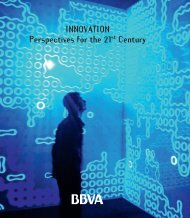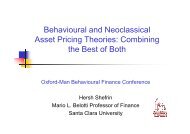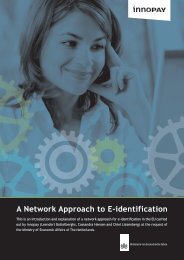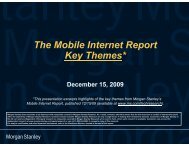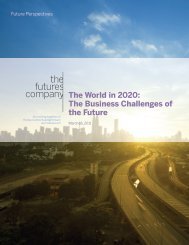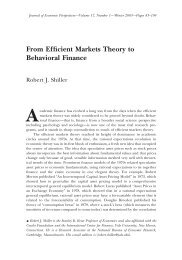Innovation 100 - The World Economic Forum
Innovation 100 - The World Economic Forum
Innovation 100 - The World Economic Forum
You also want an ePaper? Increase the reach of your titles
YUMPU automatically turns print PDFs into web optimized ePapers that Google loves.
Working DraftLast Modified 17.09.2008 15:54:40 W. Europe Standard TimePrinted 17.09.2008 15:57:41 W. Europe Standard Time<strong>Innovation</strong> <strong>100</strong>Post-meeting reportPalo Alto, CaliforniaSeptember 3 - 4, 2008
exit print contents < ><strong>World</strong> <strong>Economic</strong> <strong>Forum</strong> 1
exit print contents < ><strong>World</strong> <strong>Economic</strong> <strong>Forum</strong> 2
Table of contentsIntroduction 4Foreword 4Executive summary 7<strong>Innovation</strong> clusters 10Introductory presentation 13Synthesized insights 18<strong>Innovation</strong> talent 29Introductory presentation 33Synthesized insights 41Collaborative innovation 46Introductory presentation 49Synthesized insights 54Supporting materialSpeaker presentations6162Picture and video gallery63Participant list65<strong>The</strong> <strong>World</strong> <strong>Economic</strong> <strong>Forum</strong> would like to thank McKinsey & Company for its help in creating this post-meeting synthesis document.exit print contents < ><strong>World</strong> <strong>Economic</strong> <strong>Forum</strong> 3
IntroductionForewordForeword<strong>Innovation</strong> is at the top of the agenda for both business executives andgovernment leaders. <strong>The</strong> former knows that the future of their businessdepends on their capacity to innovate or their ability to accessinnovation. <strong>The</strong> latter understands that long-term growth and economicdevelopment ultimately rest on collective innovation, and that policymakers can affect, both positively and negatively, the climate thatencourages innovation.In response to the clear mandate from IT and telecoms CEOsto focus on these challenges, the <strong>World</strong> <strong>Economic</strong> <strong>Forum</strong> has launchedits Geography of <strong>Innovation</strong> programme. This programme aims to:1. Synthesise the best of the data available, visualising theissues through an innovative tool, the <strong>Innovation</strong> Heatmap.2. Engage the leading innovation thinkers and practitioners indiscussion on those issues which have yet to be resolved.3. To bring awareness to obstacles, best practises, and opportunities.<strong>The</strong> <strong>Innovation</strong> <strong>100</strong> meeting has been designed in close collaborationwith IT sector Industry Partners of the <strong>World</strong> <strong>Economic</strong> <strong>Forum</strong>.Industry Partnership serves as the <strong>World</strong> <strong>Economic</strong> <strong>Forum</strong>'s primarymeans for engaging its corporate partners. It leverages the <strong>Forum</strong>'sneutral platform and global networks and focuses on three areas:Industry, Cross-Industry, and Corporate Global Citizenship.In the tradition of the <strong>World</strong> <strong>Economic</strong> <strong>Forum</strong>’s multi-stakeholderapproach to global issues, this meeting convened a global set ofbusiness and academic stakeholders to share their perspectives anddevelop greater understanding through dialogue. With a focus on smallgroup discussions, brainstorming, and sharing personal experiences,this meeting’s primary focus was to enable leaders to explore thehottest innovation questions in a creative and non-partisan setting.<strong>The</strong> <strong>Innovation</strong> <strong>100</strong> meeting was an important milestone for a project thathas involved a significant programme of outreach and dialogue withmembers of the academic community, public figures, representatives ofnon-governmental organizations and business leaders from across theworld. This has involved numerous interviews as well as sessions in the<strong>World</strong> <strong>Economic</strong> <strong>Forum</strong>’s Annual Meeting of the New Champions 2007 inDalian, China; the <strong>Forum</strong>’s 2008 Annual Meeting in Davos 2008; and the<strong>World</strong> <strong>Economic</strong> <strong>Forum</strong> on East Asia in Kuala Lumpur 2008. Thisprogramme thus far has focused on the Tech Sector as a representativeof innovation thinking. <strong>The</strong> programmes expects to continue with abroader multi-industry, multi-disciplinary focus.This Report serves to document the most important outcomes from themeeting as a necessary step in evolving the dialogue. <strong>The</strong> starting pointfor this meeting was a set of core questions. On the basis of the impossibilityof definitively solving the innovation challenge, the end point willsimply be a better set of questions that can be used to shape improveddialogue and collaboration.In addition to the team identified on the next page, I would like toespecially thank on behalf of the <strong>World</strong> <strong>Economic</strong> <strong>Forum</strong> Paul Saffo andGeoffrey Moore for their world-class moderation of the meeting, DavidKirkpatrick for his highly insightful video interviewing of participants, andSimon Mulcahy for his inspiration and drive in pulling this all together.Sincerely,Alan MarcusDirector, Head of IT and Telecoms Industries<strong>World</strong> <strong>Economic</strong> <strong>Forum</strong>exit print contents < ><strong>World</strong> <strong>Economic</strong> <strong>Forum</strong> 4
<strong>Innovation</strong>clustersIntroductionClusters are geographic concentrations of the factors that contribute to creatinginnovation. Here, new ideas flourish and get commercialized. Despite excellentexisting research on the topic, there are still a lot of questions about how theseclusters are formed or evolve.<strong>The</strong> <strong>Innovation</strong> <strong>100</strong> sessions on innovation clusters focused on exploring two areas:a) how clusters can best be measured; b) which factors most impact theinnovation performance of a region. Once the issue had been framed, and acommon framework defined for the participants, groups focused in small groups oncreating success and failure scenarios for four clusters (Silicon Valley, Bangalore,Budapest and Haifa) to 2025. AnnaLee Saxenian and Chuck House providedexcellent background on how Silicon Valley had evolved.Whilst some participants believed that innovation was borderless, it was clearthat the specific strengths of regions play a significant role in shaping theinvestment decisions of corporations. How clusters can be developed to increasetheir relative innovativeness remains complex, however a clear set of factors can beidentified. Importantly, it is not enough for a cluster to optimize its local strengths; itis imperative for it to increase its connections with sister geographies to ensure theflow of ideas, talent and resources.<strong>The</strong> following pages provide a more detailed overview of the sessions.exit print contents < ><strong>World</strong> <strong>Economic</strong> <strong>Forum</strong> 11
<strong>Innovation</strong>clustersSynthesis diagram from innovation clusters sessionSource: Synthesis diagram from <strong>Innovation</strong> cluster session – produced during the meetingexit print contents < ><strong>World</strong> <strong>Economic</strong> <strong>Forum</strong> 12
<strong>Innovation</strong>clustersIntroductorypresentationDevelopment paths of innovation clustersSilicon ValleyTokyoPatents granted*, 1997 - 2006Log 2CAGRPercent12614TaipeiTel AvivOttawaSydneyBristol2815111051?Bangalore1997 98 99 2000 01 02 03 04 05 2006TimeEvolution* Overall patents granted by US patent and trademark office, by inventor origin (log base 2); partial ranking of selected citiesSource: Juan Alcacer (Harvard University); McKinsey & CompanyCurrentstatusFuturedevelopmentexit print contents < >© McKinsey & Company<strong>World</strong> <strong>Economic</strong> <strong>Forum</strong> 13
<strong>Innovation</strong>clustersIntroductorypresentationDynamics of worldwide largest innovation clustersBangalore, IndiaPatents granted, 1997 - 2006Cluster sizeHigh“Hot Spring”BrisbaneOttawa-Gatineau,TaipeiSeattle“Dynamic Ocean”Silicon ValleyMomentum*BristolHaifaTel AvivMunichStuttgartSan FranciscoMinneapolisBostonTokyoHouston“Silent Lake”Low0LowStockholmLondonPittsburghIndianapolisPhiladelphiaChicagoHigh* Growth of patents in a cluster per year from 1997 to 2006** Patents’ industry and firm diversity in a cluster in 2006Source: Juan Alcacer (Harvard University); McKinsey & CompanyVersatility**exit print contents < >© McKinsey & Company<strong>World</strong> <strong>Economic</strong> <strong>Forum</strong> 14
<strong>Innovation</strong>clustersIntroductorypresentationCharacteristics of promising innovation clustersHot SpringSilent LakeDynamic OceanEcosystem with fastgrowth fueled by newplayers in emergingsectorsStable ecosystembacked by establishedcompaniesEcosystem with vibrantlevel of activities withvast opportunities andstrong growthOrigin ofcompaniesMostly foreign playersRange from local toforeign playersMostly local playersMaturity ofcompaniesNew branches ofestablished playersEstablished playersAn ever changing mix ofestablished players andstart-upsChurn ofcompaniesModerate Low HighExamplesSource: McKinsey & Company• Penang, Malaysia• Hsinchu Science Park,Taiwan• Seattle, US• Tokyo, Japan• Silicon Valley, US• Taipei, Taiwanexit print contents < >© McKinsey & Company<strong>World</strong> <strong>Economic</strong> <strong>Forum</strong> 15
<strong>Innovation</strong>clustersIntroductorypresentationKey drivers of long-term innovativeness of a clusterInnovativenessLong-termIRationaleToday’s absolute sizeserves as platform forfuture growthShort-termTodaytTodayTimeItToday’s momentummeasures where thecluster stands on thelifecycle stage, thusindicating its likelihoodof future growthKey driversToday’s sizeToday’s momentumToday’s sizeToday’s momentumToday’s versatilityIITPharmatToday’s versatility showsthe diversity of innovationsproduced by the cluster;thus, clusters with highversatility can betterhedge against future sectorand firm downturnsSource: McKinsey & Companyexit print contents < >© McKinsey & Company<strong>World</strong> <strong>Economic</strong> <strong>Forum</strong> 16
<strong>Innovation</strong>clustersIntroductorypresentationOutlook on development potential of clustersHot Spring:greater diversity required toachieve critical size forsustainable growth and tobecome independent fromsingle sectorsDynamic Ocean:likely to be sustainable in thelong term, however,accelerating growth can helpto stay aheadSilent Lake:needs to gain momentumby adding more sectorswith high growth rates orstrongly pushing existingfast growing sectorsSource: Juan Alcacer (Harvard University); McKinsey & Companyexit print contents < >© McKinsey & Company<strong>World</strong> <strong>Economic</strong> <strong>Forum</strong> 17
<strong>Innovation</strong>clustersSynthesizedinsightsWhat is the “magic formula” for successfulinnovation clusters? (1/2)During the final synthesis of the meeting, Geoffrey Moore proposed a strawman formulafor the successful development of a cluster. <strong>The</strong> following diagram represents this workcombined with feedback from the <strong>Innovation</strong> <strong>100</strong> participants.Please turn the page fora tidied up version fromGeoffrey Moore.Source: Geoffrey Moore, Managing Partner, TCG Advisor LLC; <strong>Innovation</strong> <strong>100</strong> meeting participantsexit print contents < ><strong>World</strong> <strong>Economic</strong> <strong>Forum</strong> 18
<strong>Innovation</strong>clustersSynthesizedinsightsWhat is the “magic formula” for successfulinnovation clusters? (2/2)<strong>The</strong> single most important economic consequence of innovation is its ability to generate superior returns.In this context, “economic clusters” or zones of specialized capability have proven to be a robust mechanismfor focusing innovation to create region-specific competitive advantages. <strong>The</strong>ir desirability, in otherwords, is not in question. <strong>The</strong> issue is, what is the “formula” for how to create them?<strong>The</strong> <strong>Innovation</strong> <strong>100</strong> participants took a whack at generating just such a formula. Think of it as a trial recipe submittedto some global cookbook. It goes something like this:Assemble for differentiating capability the following ingredients ...... stir these ingredients well and pour theminto a bowl that includes the following mixture• Two universities, one strongin the sciences, the other in theliberal arts (add managementstrength to one or both)• Combine with several successfullarge corporationsfor access to seasoned management,unfulfilled innovationinitiatives, and discretionarypersonal capital to seed newventures• Add industry-specific supportservices to intensify theregion’s unique capabilities• If available, throw in one ormore “sister city”relationships with moremature economic success• And focus all efforts on asector that is high growth• A community that is grounded in rule of law• An infrastructure that supplies the requisite power,transportation, and housing needs• A “wealth accumulation culture” that celebrates andrewards individual prosperity• A society which embraces class mobility• A favorable tax policy to attract foreign investmentBon appétit.As you can see from the illustration, individual cooks have variations they prefer, and your kitchen is encouragedto “season to taste.” Finally, like any recipe, its success will largely dependent on the quality of the ingredients onecan secure to put in it.Source: Geoffrey Moore, Managing Partner, TCG Advisor LLCexit print contents < ><strong>World</strong> <strong>Economic</strong> <strong>Forum</strong> 19
<strong>Innovation</strong>clustersSynthesizedinsightsHow can currently successful clusterssustain their momentum?Source: <strong>Innovation</strong> <strong>100</strong> meetingexit print contents < ><strong>World</strong> <strong>Economic</strong> <strong>Forum</strong> 20
<strong>Innovation</strong>clustersSynthesizedinsightsHow do leaders decide where best to placetheir bets today and tomorrow? (1/4)In order to answer the question of where leaders foresee future geographic innovation hotspots,we designed a special exercise called “place your bets”, which participants carried out self-dependentlyat any point during the meeting.Imagine you are the CEO of a major technology firm. You just received a2nd round of funding to finance your expansion. Where would you deployyour assets/investments, if you intended to …While it is clear that leaders willnot provide actual investment data,they would provide an indication,as to the innovation strength ofcertain geographies on the basisof a series of questions:In particular, we asked participantsto evaluate the attractiveness ofregions for different innovationprojects. Specifically, we asked:redbluegreen• … build up a research lab to develop the next-generation personal information interface?• … develop and market the next-generation oflocation-based information services?• … develop and produce cutting alternativeenergy technology?yellow• … develop and market the next-generationrobotic/nanotech home help system?Source: <strong>Innovation</strong> <strong>100</strong> meetingexit print contents < ><strong>World</strong> <strong>Economic</strong> <strong>Forum</strong> 21
<strong>Innovation</strong>clustersSynthesizedinsightsHow do leaders decide where best to placetheir bets today and tomorrow? (2/4)Below you find snapshots of the world map on which participants placed their stickers during meeting.Source: <strong>Innovation</strong> <strong>100</strong> meetingexit print contents < ><strong>World</strong> <strong>Economic</strong> <strong>Forum</strong> 22
<strong>Innovation</strong>clustersSynthesizedinsightsHow do leaders decide where best to placetheir bets today and tomorrow? (3/4)Statistically, the responses to the fourquestions came out to the following resultsPercentage of total responses per questionEuropeUS WC(SiliconValley)US EC(NewYork) India ChinaMiddleEast Japan Other… build up a research lab to develop the nextgeneration personal information interface?31972074022… develop and market the next generation oflocation-based information services?211238060230… develop and produce cutting alternativeenergy technology?2320001518321… develop and market the next generationrobotic/nanotech home help system?22802784427Key takeaways• Attractive regions for all types of investments are Europe (esp. Spain, UK, Italy, Finland, Sweden and Germany – withfocus on R&D and energy projects), US West Coast (esp. Silicon Valley) as well as China (esp. Shanghai)• China (Beijing), India (Bangalore), Japan and US East Coast (esp. New York) also attractive clusters but more focused• Beijing attractive for alternative energy• Bangalore for robotic/nanotech and personal information interface research labs• Japan and New York for new data-based service offerings• Smaller clusters are Middle East (esp. Dubai) for energy, Korea for robotic/nanotech and Kuala Lumpur for personalinformation interface labsSource: <strong>Innovation</strong> <strong>100</strong> meetingexit print contents < ><strong>World</strong> <strong>Economic</strong> <strong>Forum</strong> 23
<strong>Innovation</strong>clustersSynthesizedinsightsHow do leaders decide where best to placetheir bets today and tomorrow? (4/4)We synthesized the vast input from participantsinto the following decision-making approach12345Decide in which innovation stage you want toparticipate, i.e., ideation vs. commercializationUnderstand and define your financing needsin terms of type and amountFigure out where your customers areFigure out how flexible you’re in adjusting tonew regional culturesCreate short list of potential clustersAn additional model was provided byGil PenchinaHighGo toAsiaDo it inthe Valley6Compare short-listed clusters for• <strong>The</strong>ir focus on innovation stage• <strong>The</strong>ir focus on industries• <strong>The</strong> availability of financing by localuniversities, large firms, etc.• <strong>The</strong>ir proximity to customers• <strong>The</strong>ir (regional) cultureNeedforspeedLowAnywhereEasternEuropeNon-coreCore7Decide on your cluster!Source: Gil Penchina, sketch during breakoutFunctionSource: <strong>Innovation</strong> <strong>100</strong> meetingexit print contents < ><strong>World</strong> <strong>Economic</strong> <strong>Forum</strong> 24
<strong>Innovation</strong>clustersSynthesizedinsightsWhat’s the Valley like in 2025 and howdoes it get there?Key future success drivers• Strenghten entrepreneurialspirit• Attract talent and improveyield of local talent• Provide sufficient venturecapitalSource: <strong>Innovation</strong> <strong>100</strong> meetingexit print contents < ><strong>World</strong> <strong>Economic</strong> <strong>Forum</strong> 25
<strong>Innovation</strong>clustersSynthesizedinsightsWhat’s Haifa like in 2025 and howdoes it get there?Key future success drivers• Stabilise political situationand develop meta plan• Leverage regionalcompetitive advantage• Import talentSource: <strong>Innovation</strong> <strong>100</strong> meetingexit print contents < ><strong>World</strong> <strong>Economic</strong> <strong>Forum</strong> 26
<strong>Innovation</strong>clustersSynthesizedinsightsWhat’s Budapest like in 2025 and howdoes it get there?Key future success drivers• Develop measurable milestoneplan and strictlyexecute• Focus investments onone industry• Further improve educationSource: <strong>Innovation</strong> <strong>100</strong> meetingexit print contents < ><strong>World</strong> <strong>Economic</strong> <strong>Forum</strong> 27
<strong>Innovation</strong>clustersSynthesizedinsightsWhat’s Bangalore like in 2025 and howdoes it get there?Key future success drivers• Improve physicalinfrastructure• Foster entrepreneurialspirit• Invest in educationSource: <strong>Innovation</strong> <strong>100</strong> meetingexit print contents < ><strong>World</strong> <strong>Economic</strong> <strong>Forum</strong> 28
<strong>Innovation</strong> talentexit print contents < ><strong>World</strong> <strong>Economic</strong> <strong>Forum</strong> 29
<strong>Innovation</strong>talentIntroduction<strong>The</strong> topic of talent has been central in all discussions around innovation. <strong>The</strong>innovation <strong>100</strong> meeting looked at this from two perspectives: the supply anddemand of talent, as well as the enablement of talent.<strong>The</strong> supply of talent is undergoing a dramatic shift with major changes to demographics,numbers of returnees, and cultural factors, such as four generations in thesame work-place. Demand is also changing due to greater demand in the techsector or for cross-sectoral skills, the consumerization of IT, and the changing natureof business. <strong>The</strong> <strong>Innovation</strong> <strong>100</strong> meeting looked at these issues in detail, providingparticipants with a preliminary “talent dashboard”.How organisations enable their talent to contribute and innovate was a highlycharged discussion. With talent being employed more globally, increasing the flowof ideas from the periphery to the centre was regarded as critical. Prith Banerjeeand Guido Jouret explained HP’s and Cisco’s respective approaches to provide astarting point for discussion, after which small groups concentrated on sharing ideason approaches that could be used to influence corporate culture and increase theflow of ideas from the periphery to the centre.Whilst innovation may once have been driven by a small few, it was clear that“innovation talent” today includes a much broader set of contributors acrossthe organisation (as well as outside – covered in next session). New managementapproaches are needed to engage larger numbers of talented innovators – includingbreaking down problems, aligning larger numbers of talent with the problems,resynthesizing their ideas faster into innovations, and providing the right corporateculture to nurture and incentivize this behaviour.exit print contents < ><strong>World</strong> <strong>Economic</strong> <strong>Forum</strong> 30
<strong>Innovation</strong>talentSynthesis diagram from innovation talent sessionSource: Synthesis diagram from innovation talent session – produced during the meetingexit print contents < ><strong>World</strong> <strong>Economic</strong> <strong>Forum</strong> 31
<strong>Innovation</strong>talentHow do participants define innovation talent?Participants were asked to come up with their definition of talent during the lunch break. Below aresome of the definitions which participants shared during the kick-off for the innovation talent sessionat the <strong>Innovation</strong> <strong>100</strong> meeting.Source: <strong>Innovation</strong> <strong>100</strong> meetingexit print contents < ><strong>World</strong> <strong>Economic</strong> <strong>Forum</strong> 32
<strong>Innovation</strong>talentIntroductorypresentationGlobal talent landscapeTalent temperatureHotWarmCoolExampleSILICON VALLEY, USMinRelative ranking comparedto global peersMaxHuman capitalScience &Engineering skillsManagement skillsWorking populationaged 19 - 59MillionsNumber of S&EgraduatesThousandsNumber of business/law graduatesThousandsHot1.0429.7158.1Quality of generaleducationIndexQuality of S&EeducationIndexQuality of managementeducationIndexWarm5.1 4.55.8Physical connectivityMillions of passengersAcademic intensityIndexNumber of companiesin top 2000 worldwideCool11.0 50.0592.0Source: McKinsey & Companyexit print contents < >© McKinsey & Company<strong>World</strong> <strong>Economic</strong> <strong>Forum</strong> 33
<strong>Innovation</strong>talentFeedback tointroductorypresentationHow can we enhance the city talent dashboard?“In a digital world, how could wecapture creative arts skills?”“To assess whether this group candesign and innovate in a globalenvironment, a metric for talent’sglobal perspective would be great, e.g.the percentage of foreign students.”“I feel it is important to measure theability to bridge across verticals,create common language, e.g. bylooking at the role of journalism in theinnovation ecosystem.”“For the management skill category, Ifeel it is important to also includestartup activity as this is a verydifferent but highly important talentskill set.”“I am missing a vertical, it has to dowith talent in the financial business,people who have their hands of themoney and possibly a metric onphilanthropy.”Source: <strong>Innovation</strong> <strong>100</strong> meetingexit print contents < ><strong>World</strong> <strong>Economic</strong> <strong>Forum</strong> 34
<strong>Innovation</strong>talentIntroductorypresentationRegional talent challengesDeveloped countries,historically stronglydependent onforeign talentDeveloped countries,historically with lowdependencyon foreign talentDeveloping countriesIllustrativeexampleKeyproblemAttracting top talentincreasingly difficultdue to deterioratingrelative attractivenessfor talentQuick widening ofexisting talent supplygap due to drasticaging of populationDespite enormous rawsupply, shortage fortalent with specializedskills due to strongeconomic growthSource: McKinsey & Companyexit print contents < >© McKinsey & Company<strong>World</strong> <strong>Economic</strong> <strong>Forum</strong> 35
<strong>Innovation</strong>talentIntroductorypresentationNew paradigm of talent dynamicsDemographic shiftsdiminishing traditionalpopulation pools whilenew countries emergewith excess supplyReverse talent flowswith high short termmobility but lower stayratio in the mid termNew talentparadigmNew breed of talentdue to changing tasks,organizational environments,and generationalvalue shiftsSource: McKinsey & Companyexit print contents < >© McKinsey & Company<strong>World</strong> <strong>Economic</strong> <strong>Forum</strong> 36
<strong>Innovation</strong>talentIntroductorypresentationSignificant global demographic shiftsDependency of non-working population on working population*Percent120<strong>100</strong>80RussiaGermanyChinaSingaporeUS601950USGermanySingaporeChinaRussia2005IndiaIraqSudanNigeria2050* Defined as share of population aged 0 - 14 and 65+ divided by share of working population aged 15 - 64Source: UN <strong>World</strong> Population Prospect 2006; McKinsey & Companyexit print contents < >© McKinsey & Company<strong>World</strong> <strong>Economic</strong> <strong>Forum</strong> 37
<strong>Innovation</strong>talentIntroductorypresentationDecreasing stay ratio of foreign studentsCHINA EXAMPLENumber of Chinese studentsstudying abroadThousands120125117115119Stay rate ofChinese studentsPercent134<strong>100</strong>90906080307002002 03 04052006Source: Main <strong>Economic</strong> Indicators April 2008 (OECD), UN Demographic Database; Chinese national statistics; McKinsey & Companyexit print contents < >© McKinsey & Company<strong>World</strong> <strong>Economic</strong> <strong>Forum</strong> 38
<strong>Innovation</strong>talentIntroductorypresentationChanging demand and supply of new talent breedChanging demanddue to shift in tasks andorganisational environmentsChange in US employments1998 - 2004, in percentTransformational-13.63.1Transactional8.7TacitTechnology-enabled virtualizationof organisationsDemand and supply of newbreeds of talent• Demand for more sophisticallyeducated, interactive, andcross-cultural communicatorsand complex problem solvers• Workforce supply consisting offour generations with diverseexpectations, skills and valuesfor the first time in historyChanging supplydue to generational value shiftsVeteransGeneration XBaby boomersMillenialsSource: Bureau of Labor Statistics; McKinsey & Companyexit print contents < >© McKinsey & Company<strong>World</strong> <strong>Economic</strong> <strong>Forum</strong> 39
<strong>Innovation</strong>talentIntroductorypresentationNeed to act nowLong-term focus, ~ 2020Mid-term focus, ~ 2012Short-term focus, 2009Attract andretain• Flexible immigration• Competitive incentives• Superior living andbusiness environmentIncrease localyield• Targeted companytalent development/training• Sophisticated tertiaryeducation• Sophisticated basicand tertiary educationUnleash offshorepotential• Outsourcing/offshoringinto transaction centers• Global businesspartner ecosystem• Outsourcing/offshoringinto competencecentersNeedto act nowMonday, Sep 8, 2008Source: McKinsey & Company2020exit print contents < >© McKinsey & Company<strong>World</strong> <strong>Economic</strong> <strong>Forum</strong> 40
<strong>Innovation</strong>talentSynthesizedinsightsbreakout IHow to attract and retain talent?Global talent sourcing• Necessity to differentiate between attraction, developmentand enablement in talent management• Need to plant a local seed and have a localpartner to create a local working experience,e.g., via buy-in, local partners, professionaltalent scout• Rotational programs key, even forced for 2 - 3 years• Strike the right balance in talent managementbetween “think global and think local”Subprime credit crunch• Talent surplus due to subprime credit crunch– Higher fluctuation and reconfiguration oftalent pool ("talent recycling"), higheravailability of qualified talent for startups– Collaborative innovation fostered due tolimited funding for full range of R&D, thusconcentration on core activitiesSource: <strong>Innovation</strong> <strong>100</strong> meetingAttractand retainPyramid economics• Talent pyramid as conceptualization of how labourinputs are currently structured• Pyramid currently "cut" half-way down due tooutsourcing to low-wage countries• Structure could change significantly in the future– Invert as automation replaces people in thebottom of the pyramid– <strong>The</strong> bottom could be replaced by a cloud– Could be split vertically as skill levels increasein low-wage countries• Driving factors are– Rising skill levels across Asia– Reversal of "create in west, customize for east"– Lack of exposure to Asia amongst Westernstudents as opposed to Asian students– Rise of India and China as "people continents" -meaning markets and deep talent pools“<strong>The</strong> best people you don’t find – they find you!”<strong>Innovation</strong> <strong>100</strong> participant“People are different – some are more creative, some are doers, helpers,etc. So creating value through new ideas that are implemented to createvalue takes teams of people. Talent is collective.”<strong>Innovation</strong> <strong>100</strong> participantexit print contents < ><strong>World</strong> <strong>Economic</strong> <strong>Forum</strong> 41
<strong>Innovation</strong>talentSynthesizedinsightsbreakout IHow to increase local yield?Education• Education crucial to convey key innovation skillsthroughout educational career, such as– Open/questioning frame of mind– Ability to ask the right question– Cross-disciplinary perspective, i.e. balancedexperience in S&E vs. liberal arts disciplines– Interactive communication skills– Awareness of team over individual– Balanced integrative vs. analytical skills– Healthy self-doubt• Internet in education two edged sword– Helps to innovate through synthesis, i.e.ask the right (meta) questions by usingWikipedia, etc.– Allows quick answers, thus loss of ability tothink self-dependentlyIncreaselocal yieldCulture• <strong>The</strong> innovation ability of top talent is relativelyindependent of cultural/geographic background,however, mixed cultural site verybeneficial, e.g., Intel with massive data setshowing little difference in innovation outputacross lab sites• One cultural factor seems to matter in societyand education, however: Tolerance for failure,e.g., failure resume exercise“Innate innovators will innovate in spite of the system.”<strong>Innovation</strong> <strong>100</strong> participant“If you have real talent, culture does not matter. It only does if talent isnot that spiky”<strong>Innovation</strong> <strong>100</strong> participantSource: <strong>Innovation</strong> <strong>100</strong> meetingexit print contents < ><strong>World</strong> <strong>Economic</strong> <strong>Forum</strong> 42
<strong>Innovation</strong>talentSynthesizedinsightsbreakout IHow to unleash India’s talent potential?India’s talent challenge• Existing education models don’t work in India dueto its scale, thus difficult for these countries toreplicate successful environments such asCalifornia• Private sector tries to fill deficiencies ofeducational system as professional curriculumdeveloped by firms, e.g. Infosys, Satyam, Wipro• Availability of professional mentors beyondeducational system is keyUnleashIndia’spotentialKey levers for Indian governmentServicesKnowledge accessKey leversfor IndiangovernmentConceptsApplicationCreation“<strong>The</strong>re are more jobs to fill than there are candidates to fill them, thisranges from truck drivers to engineers”<strong>Innovation</strong> <strong>100</strong> participantSource: <strong>Innovation</strong> <strong>100</strong> meetingexit print contents < ><strong>World</strong> <strong>Economic</strong> <strong>Forum</strong> 43
<strong>Innovation</strong>talentSynthesizedinsights paneldiscussionHow to maximise talents’ idea creation potential?Maximise idea creation potentialCase study HP: Prith Banerjee• Balance alignment of research toproduct strategy with fundamentalresearch• Focus on high-impact research, i.e.,place big but focused bets, split researchportfolio (1/3 fundamental, 1/3 applied,1/3 product development)• Share R&D topics on the web, resultingin 450 proposals from 200 universitiesin 28 countries)Case study Cisco: Guido Jouret• Embrace wisdom of crowds, but embedpersonal accountability from idea to end,e.g., internal competitions of teams toforce sacrifice of personal credibility• Foster diversity of opinions• Support process of initial founders fromideation to commercialization• Acquire technology, however, higherintegration risks due to lower adjacencyto existing product portfolioSource: <strong>Innovation</strong> <strong>100</strong> meetingexit print contents < ><strong>World</strong> <strong>Economic</strong> <strong>Forum</strong> 44
<strong>Innovation</strong>talentSynthesizedinsightsbreakout IIHow to get ideas from the periphery to the centre?Change culture/leadership• Install clear connectors andshare success across teams• Install new BU head forinnovation but beware toalienate traditional BUswhich act as cash cows• Beware of elite ideas unitswhich create “us” vs. “them”mentality• Foster aggressive bottomupthinking against resistancefrom in-control leadership• Communicate strategyclearly, strictly prioritize anddecide if proximity to marketis necessary (keep idea inperiphery then)Generate and develop internal ideas• Create incentives forinnovative employees in formsof resources, prestige orempowerment• Create internal platforms forproduct creation, discussionforums, a Wiki game• Set time limits, tie incentivesand rewards to timelyrealisation of milestonesFoster external ideas• Tap into new global and localtrends (e.g., obesity) toredefine core competencies• Capture outside ideas inexisting and potential usergroups, make use of fastprototyping• Create external platforms forproduct creation, discussionforums, a Wiki game• Give away development toolsto universities/design schoolsSource: <strong>Innovation</strong> <strong>100</strong> meetingexit print contents < ><strong>World</strong> <strong>Economic</strong> <strong>Forum</strong> 45
Collaborative innovationexit print contents < ><strong>World</strong> <strong>Economic</strong> <strong>Forum</strong> 46
CollaborativeinnovationIntroductionMost leading innovation practitioners understand the significant potential value inmaximising the engagement of external collaborators in the innovation process.We showed through a powerful “human histogram” how marked movement ofinnovation is towards users and Web-based collaboration. Despite this development,many business leaders are holding back.We explored if there was indeed a movement towards open and collaborativeinnovation, concluding that there was indeed plenty of smoke here.We heard from Ross Piper at Salesforce.com, Dwayne Spradlin at Innocentive andMark Turrell at Imaginatik of business models that successfully employ collaborationat the heart of their innovation – proving there is fire at the end of the smoke.<strong>The</strong> majority of the meeting was spent exploring what factors were preventingmomentum for the general business population. Chief among the reasons was thelack of clarity on how to balance the risks and predictably make money out ofthis. <strong>The</strong>re is still a lack of clarity as to what options are available, what managementand technology tools to use, and how to measure success. Interestingly, manyleaders emphasized that they see themselves as more and more collaborative,but not necessarily open yet.Source: <strong>Innovation</strong> <strong>100</strong> meetingexit print contents < ><strong>World</strong> <strong>Economic</strong> <strong>Forum</strong> 47
CollaborativeinnovationSynthesis diagram from collaborative innovationsessionSource: Synthesis diagram from collaborative innovation session – produced during the meetingexit print contents < ><strong>World</strong> <strong>Economic</strong> <strong>Forum</strong> 48
CollaborativeinnovationIntroductorypresentationCollaborative innovation – a frameworkCompany R&DOpen innovationMass innovationSource: McKinsey & Company<strong>Innovation</strong> exclusively generated byinternal company R&D<strong>Innovation</strong> generated by companyR&D together with a well-establishednetwork of suppliers, academics,consortia, etc. in a long-term, trustbased,stable relationship<strong>Innovation</strong> generated by reaching outto a larger network of external participants(lead users, external specialists,enthusiasts, etc.) who can contribute ona more variable and self-defined basisexit print contents < >© McKinsey & Company<strong>World</strong> <strong>Economic</strong> <strong>Forum</strong> 49
CollaborativeinnovationIntroductorypresentationUse of collaborative innovationUse of external sources in innovation process*Percent of respondentsCompany R&DNo externalsources18Suppliers67Open innovationMass innovationResearchpartnershipsAcademicpartnershipsConsumernetworks181934* Response to the question: “please select the most important and second-most important external source of support”, n = 984Source: McKinsey & Companyexit print contents < >© McKinsey & Company<strong>World</strong> <strong>Economic</strong> <strong>Forum</strong> 50
CollaborativeinnovationIntroductorypresentationImpact of collaborative innovationPercent of companies engaging in ...... open innovationLow performers61High performers74... mass innovationLow performers0High performers35Source: Cooper, R.G./Edgett, S.J. 2008, "Maximizing productivity in product innovation“; McKinsey & Companyexit print contents < >© McKinsey & Company<strong>World</strong> <strong>Economic</strong> <strong>Forum</strong> 51
CollaborativeinnovationIntroductorypresentationForms of collaborative innovationUnconstrainedDegree ofopennessIP owned byCompanyCommunityMassinnovationOpen sourceChoiceofpartnerMob sourceCrowd sourceLead userConstrainedOpeninnovationContract-basedSelf-definedSource: McKinsey & CompanyType of relationship with external partnerexit print contents < >© McKinsey & Company<strong>World</strong> <strong>Economic</strong> <strong>Forum</strong> 52
CollaborativeinnovationIntroductorypresentationWhat’s next?What is collaborative innovation, and which forms are gaining currency?How are leaders perceiving the shift towards “open”?How can organisations open up without losing control? How canappropriate governance structures be defined and quality controlbe ensured?How can a culture be established that allows collaborative innovationto flourish?How can the best ideas be incentivized, success measured,and contribution rewarded?How are leaders revaluating IP protection in light of increasingopenness? What new models are gaining favour?What key technologies are achieving the greatest success, and howwill they evolve?Source: McKinsey & CompanyA common ground for the discussionexit print contents < >© McKinsey & Company<strong>World</strong> <strong>Economic</strong> <strong>Forum</strong> 53
CollaborativeinnovationSynthesizedinsights humanhistogramWill companies open up in the next 5 years? (1/2)<strong>The</strong> Human HistogramWe tried for months to get statistical data on the evolution ofcollaborative innovation. This does not seem to exist.Interviewees in the run-up to this meeting were very clear onhow much they wanted to understand how significant othersconsidered the collaborative innovation movement to be.Our response was to create a human histogram, gettingparticipants to physically stand where they are today andwould be in 5 years. Geoffrey Moore conducted interviews live.<strong>The</strong> statistics on the following page capture what happenednumerically, but can not communicate the powerful feeling ofshift towards open collaboration in the room.Watch the video on how it happenedSource: <strong>Innovation</strong> <strong>100</strong> meetingexit print contents < ><strong>World</strong> <strong>Economic</strong> <strong>Forum</strong> 54
CollaborativeinnovationSynthesizedinsights humanhistogramWill companies open up in the next 5 years? (2/2)Mindshare today: in terms of your overallcommittment to innovation how much emphasisdoes collaborative innovation get today?Participant histogram, percentFuture share of wallet: in 5 years, what percentageof your organisation’s innovation portfolio will beattributable to collaborative innovationParticipant histogram, percent2008 201313106491 - <strong>100</strong>81 - 9071 - 8061 - 7013172121“<strong>The</strong> ability of companiesto open up islimited today, but willimprove in the future”<strong>Innovation</strong> <strong>100</strong>participant“Even though our companywill innovate collaboratively,it does notmean that internal R&Dwill cease to exist”<strong>Innovation</strong> <strong>100</strong>participant13131510851 - 6041 - 5031 - 4021 - 3011 - 20026101080 - <strong>100</strong>Source: <strong>Innovation</strong> <strong>100</strong> meeting<strong>The</strong> shape of this chart … what does it mean? Does this suggest westill need greater clarity on what is collaborative innovation?exit print contents < ><strong>World</strong> <strong>Economic</strong> <strong>Forum</strong> 55
CollaborativeinnovationSynthesizedinsights paneldiscussionWhat do practitioners say aboutcollaborative innovation? (1/3)Panel discussion with Dwayne Spradlin, Innocentive• Innocentive is a “market place” for innovations• Companies and non-profit organisations put upchallenges and seek solutions from a large networkof solvers• Main incentives for solvers are economic benefits(several challenges have cash reward) and reputation(being a “top solver” is usually listed on CV)• Challenge for companies is to put out a clear problemstatement• Challenge for non-profit organisations is the reluctanceto be openSource: <strong>Innovation</strong> <strong>100</strong> meetingexit print contents < ><strong>World</strong> <strong>Economic</strong> <strong>Forum</strong> 56
CollaborativeinnovationSynthesizedinsights paneldiscussionWhat do practitioners say aboutcollaborative innovation? (2/3)Panel discussion with Mark Turrell, Imaginatik• Imaginatik is a provider of platforms for enterprises toenable collaboration and exchange of ideas among theemployees of the company• Imaginatik puts platform and also processes in place,since several companies have the tools available butdon't get people to use them• Crucial to understand the company culture and adapttechnology to fit the culture, no one-size-fits-allsolution exists for collaboration• Challenge is to develop back-end of system thatreviews and filters the ideasSource: <strong>Innovation</strong> <strong>100</strong> meetingexit print contents < ><strong>World</strong> <strong>Economic</strong> <strong>Forum</strong> 57
CollaborativeinnovationSynthesizedinsights paneldiscussionWhat do practitioners say aboutcollaborative innovation? (3/3)Panel discussion with Ross Piper, Salesforce.com• Salesforce.com's customers buy licenses and log in toservices offered on their platform• All customers are on the same platform• Collaborative innovation is at the core of the businessmodel and happens in three ways:– Customer feedback is the primary mechanism toshape Salesforce.com’s investments and productdevelopment– Independent software vendors can identify amissing innovation and “fill the gap” - 860 customapplications exist in this way on Salesforce.com’splatform– Users can easily create their own applications tosupplement the core product. 81,000 customerapplications have been created• In all three instances, the improvements made for onecustomer are available to all immediatelySource: <strong>Innovation</strong> <strong>100</strong> meetingexit print contents < ><strong>World</strong> <strong>Economic</strong> <strong>Forum</strong> 58
CollaborativeinnovationSynthesizedinsightsbreakoutHow to best leverage collaborativeinnovation? (1/2)1 Define strategy2Set up organization• Establish culture of openness• Employ supporting technology3Execute dynamicallyDefinecollaborationmodelforprojectDefine IP strategyfor projectEstablish governancestructureDesign incentivemodelFrameproblemCapturecontributionsChoosesolutionProvide feedbackandcelebrateFastprototypingImplementsolutionThink in terms of dynamic IP<strong>The</strong>re is no such thing as a finished productSource: <strong>Innovation</strong> <strong>100</strong> meetingexit print contents < ><strong>World</strong> <strong>Economic</strong> <strong>Forum</strong> 59
CollaborativeinnovationSynthesizedinsightsbreakoutHow to best leverage collaborativeinnovation? (2/2)Define IP strategy• Crucial to have holistic IP strategy and open-source policy– Leverage public contributions by building proprietary IPon top of open IP– Recognize innovation dynamics and decide how toevolve IP strategy, e.g., proximity/collaboration withcompetitors• Manage lack of transparency in who owns what, i.e.,differentiate the right to own, support/sell, publish or modify• Differentiate approaches by sectors and size of company• Decide on shelf life of IP, as dynamic advantages, e.g. firstmover, network effects, talent attraction, may decreaseimportance of static IP advantages, e.g. patent protectionDesign incentive model• Align two kinds of incentives, i.e.,– Company’s incentives, e.g., cost saving, reuse– Individual’s incentives, e.g., dissatisfaction with currentsolution, reputation• Strongest incentive for individuals is brand of company,e.g., Cisco and Google have such powerful brands thatstart-ups come up with the sole aim of being acquired bythese companies• Prizes are good incentives to gather ideas, although rathershort-lived, e.g., Satyam – identified good ideas through aone-time firm-wide contestEstablish culture of openness• 4 key levers for creating change in culture– Common understanding– Role models– Systems and skills– Incentives• First step is to encourage collaborative innovationinternally, before collaborating with external stakeholdersEmploy supporting technologies• Wikis, virtual team rooms and immersive videoconferencingsystems as key technologies• Critical attributes for the technologies, i.e. ease-of-use (canfunction without IT support), ubiquitous and interoperable,visible ownership (celebrate heroes), open to all levelswithin organisation, enable searching, archiving and re-useof ideas but compliant with audit/legal requirements• Tools that can synthesize ideas more valuable than rawidea• Tools should be business-led and establish direct link toprocess of innovationSource: <strong>Innovation</strong> <strong>100</strong> meetingexit print contents < ><strong>World</strong> <strong>Economic</strong> <strong>Forum</strong> 60
Supporting materialexit print contents < ><strong>World</strong> <strong>Economic</strong> <strong>Forum</strong> 61
SupportingmaterialSpeaker presentationsSpeaker presentationsSpeaker presentationsPresentation Manuel TrajtenbergPresentation Geoffrey MoorePresentation Annalee SaxenianPresentation Stephen Oesterleexit print contents < ><strong>World</strong> <strong>Economic</strong> <strong>Forum</strong> 62
SupportingmaterialPicture andvideo galleryPicture and video gallery (1/2)Pictures<strong>Innovation</strong> <strong>100</strong> picturesVideos – InterviewsMatt BrossTim BrownJudy EstrinMaja KusmanavichBruno LanvinLoïc Le MeurGil PenchinaSam PitrodaDan ShineMark TurrellYossi VardiMichael WolfJacob ZivChief Technology Officer, BT GroupPresident, Chief Executive Officer, and PartnerChief Executive OfficerPresidentExecutive Director, eLabFounder and Chief Executive OfficerChief Executive OfficerChairmanVice PresidentCo-Founder and Chief Executive OfficerChairmanPrincipalPresident EmeritusBT PlcIDEO Inc.Jlabs LLcFoAMINSEADSeesmicWikia Inc.National Knowledge Commission of India50x15 InitiativeImaginatik plcInternational Technologies VenturesFarallon Point Inc.Israel Academy of Sciences and Humanitiesexit print contents < ><strong>World</strong> <strong>Economic</strong> <strong>Forum</strong> 63
SupportingmaterialPicture andvideo galleryPicture and video gallery (2/2)Videos – Day 1Kevin Steinberg and Alan Marcus – Introduction to <strong>World</strong> <strong>Economic</strong> <strong>Forum</strong>Simon Mulcahy – Introduction to <strong>Innovation</strong> <strong>100</strong> meetingPaul Saffo – Introduction Day 1Videos – Day 2<strong>The</strong> human histogram on collaborative innovationGeoffrey Moore – Closing Day 2exit print contents < ><strong>World</strong> <strong>Economic</strong> <strong>Forum</strong> 64
SupportingmaterialParticipant listParticipant list (1/5)NameTitleCompanyCountryRazmik AbnousJuan AlcacerAndré AndonianPrith BanerjeeTom BishopSteven Gary BlankAdam BlyMatt BrossTim BrownJean-Claude BurgelmanTom ByersCurtis CarlsonFabio CavalliTimothy ChenAdrian CheokPer ErikssonChief Technology Officer, Content Managementand ArchivingAssociate Professor of Business AdministrationDirector, EMEA High Tech LeaderSenior Vice President for Research and Director ofHP LabsVice President and Chief Technology OfficerChairman, Lecturer, Serial EntrepreneurFounder, Chief Executive Officer and Editor-in-ChiefChief Technology Officer, BT GroupPresident, Chief Executive Officer, and PartnerAdvisor, Bureau of European Policy Advisers (BEPA)Professor and Director, Stanford TechnologyVentures ProgramPresident and Chief Executive OfficerChief Executive Officer and Chief Business ArchitectChairman of Dopod, Vice President of BusinessDevelopment, VIA TechnologiesDirector, Mixed Reality LabDirector GeneralEMC Inc.Harvard UniversityMcKinsey & CompanyHPBMC Software Inc.Audubon California,Stanford University,University of CaliforniaBerkeleySeed Media GroupBT PlcIDEO Inc.European CommissionStanford UniversitySRI InternationalmondoBIOTECH AGHTC-VIAInteractive and DigitalMedia Institute (IDM)VINNOVAUSAUSAGermanyUSAUSAUSAUSAUnited KingdomUSABelgiumUSAUSASwitzerlandTaiwan, ChinaSingaporeSwedenexit print contents < ><strong>World</strong> <strong>Economic</strong> <strong>Forum</strong> 65
SupportingmaterialParticipant listParticipant list (2/5)NameTitleCompanyCountryJudy EstrinAnders FlodströmJean-Marc FrangosJeff FurmanTill M. GuldimannJohn HagelCharles H. HouseTom IlubeYoko IshikuraGuido JouretMichael A. KellerShami KhoranaPradeep KhoslaDavid KirkpatrickHarel KodeshYasuhiro KoikeJeff KowalskiChief Executive OfficerDirector GeneralSenior Vice President, Technology & <strong>Innovation</strong>Assistant Professor, Strategy & Policy DepartmentVice ChairmanDirectorExecutive Director, Media XChief Executive OfficerProfessor, Graduate School of International CorporateStrategy (ICS)Chief Technology Officer, Emerging TechnologiesGroupUniversity Librarian and Director, AcademicInformation ResourcesPresidentDean, College of Engineering, and Founding Director,CyLabSenior Editor, Internet and TechnologyChief Product OfficerProfessor, Faculty of Science and TechnologyChief Technology OfficerJlabs LLc<strong>The</strong> Swedish NationalAgency for HigherEducationBT GroupBoston UniversitySunGard Data Systems Inc.Deloitte Consulting LPPStanford UniversityGarlik LtdHitotsubashi UniversityCiscoStanford UniversityLibrariesHCL America Inc.Carnegie Mellon UniversityFortune MagazineAmdocs Inc.Keio UniversityAutodesk Inc.USASwedenUSAUSAUSAUSAUSAUnited KingdomJapanUSAUSAUSAUSAUSAUSAJapanUSAexit print contents < ><strong>World</strong> <strong>Economic</strong> <strong>Forum</strong> 66
SupportingmaterialParticipant listParticipant list (3/5)NameTitleCompanyCountryMaja KuzmanovicBruno LanvinCorinna E. LathanLoïc Le MeurDan'l LewinMark S. LewisSelina LoTom MalloyAlan MarcusNathan MarstonDan MaydanLew McCrearyAlan McNabLenny MendoncaWilliam F. MillerGeoffrey MooreDavid NordforsStephen N. OesterleDennis PamlinGil PenchinaPresidentExecutive Director, eLabBoard Chair and Chief Executive OfficerFounder and Chief Executive OfficerCorporate Vice-President for Strategic and EmergingBusinessPresident, Content Management and ArchivingPresident and Chief Executive OfficerSenior Vice President and Chief Software ArchitectDirector, IT and Telecommunications IndustriesPrincipalChairman EmeritusSenior EditorPresidentDirectorProfessor of Public and Private Management,Emeritus, Graduate School of BusinessManaging PartnerDirector, <strong>Innovation</strong> Journalism and Senior ResearchScholar, Stanford Center for <strong>Innovation</strong>s in LearningSenior Vice President, Medicine and TechnologyGlobal Policy AdviserChief Executive OfficerFoAMINSEADAnthroTronix Inc.SeesmicMicrosoft CorporationEMC Inc.Ruckus Wireless Inc.Adobe Systems Inc.<strong>World</strong> <strong>Economic</strong> <strong>Forum</strong>McKinsey & CompanyApplied MaterialsHarvard Business ReviewMcNab & Associates, LLPMcKinsey & CompanyStanford UniversityTCG Advisors LLCStanford UniversityMedtronic Inc.WWF – <strong>World</strong> Wide Fundfor NatureWikia Inc.BelgiumFranceUSAUSAUSAUSAUSAUSAUSAUnited KingdomUSAUSAUSAUSAUSAUSAUSAUSASwedenUSAexit print contents < ><strong>World</strong> <strong>Economic</strong> <strong>Forum</strong> 67
SupportingmaterialParticipant listParticipant list (4/5)NameTitleCompanyCountryJohn L. PetersenRoss PiperSam PitrodaNavi RadjouVenky RaoPaul M. RomerPaul L. SaffoPamela SamuelsonSoumodip SarkarAnnaLee SaxenianJean-Bernard SchmidtDan ShineMark SpelmanDwayne SpradlinDavid SprengKevin SteinbergFounder and PresidentSenior Vice President, Enterprise StrategyChairmanVice PresidentVice President, Head of <strong>Innovation</strong> and LeadershipEnablement in the Real Time Leadership CenterProfessor of <strong>Economic</strong>sAuthor and ForecasterDirectorProfessorDean, School of InformationChairman and Managing PartnerVice PresidentPresidentHead, Global StrategyPresident and Chief Executive OfficerFounder and Managing PartnerChief Operating Officer<strong>The</strong> Arlington InstituteSalesforce.comNational KnowledgeCommission of IndiaForrester Research Inc.Satyam Computer ServicesLtdStanford Graduate Schoolof BusinessSaffo.comBerkeley Center for Lawand TechnologyCentro de Estudos eFormaçãoAvançadaemGestão e EconomiaUniversity of California,BerkeleySofinnova Partners50x15 Initiative50x15 Foundation, AMDAccentureInnoCentive Inc.Crescendo Ventures<strong>World</strong> <strong>Economic</strong> <strong>Forum</strong>USAUSAIndiaUSAIndiaUSAUSAUSAPortugalUSAFranceUSAUnited KingdomUSAUSAUSAexit print contents < ><strong>World</strong> <strong>Economic</strong> <strong>Forum</strong> 68
SupportingmaterialParticipant listParticipant list (5/5)NameTitleCompanyCountryScott SternWilliam SwopeHiroshi TasakaManuel TrajtenbergMark TurrellYossi VardiTrae VassalloIvaturi VijayakumarMichael J. WolfJacob ZivAssociate Professor, Management & Strategy,Kellogg School of ManagementCorporate Vice President and General Manager,Corporate Affairs GroupProfessorProfessor of <strong>Economic</strong>sCo-Founder and Chief Executive OfficerChairmanPartnerChief Technology OfficerPrincipalPresident EmeritusNorthwestern UniversityIntel CorporationTama UniversityTel Aviv UniversityImaginatik plcInternational TechnologiesVenturesKleiner Perkins Caufield &Byers (KPCB)Wipro TechnologiesFarallon Point Inc.Israel Academy of Sciencesand HumanitiesUSAUSAJapanIsraelUnited KingdomIsraelUSAIndiaUSAIsraelIt is the policy of the <strong>World</strong> <strong>Economic</strong> <strong>Forum</strong> to safeguard the privacy of its Members and participants bypreventing any misuse of personal information provided to us for the purpose of facilitating contact anddialogue in furtherance of the <strong>Forum</strong>'s mission.• All participants in any <strong>World</strong> <strong>Economic</strong> <strong>Forum</strong> activity agree to treat any information related to the list ofparticipants and participant contact information as strictly confidential and to use it solely to facilitatepersonal communication among participants of <strong>World</strong> <strong>Economic</strong> <strong>Forum</strong> activities.• <strong>The</strong>y agree that this information shall not be used for any other purpose, including solicitation for commercialendeavours.• In case of violation of this rule, the <strong>World</strong> <strong>Economic</strong> <strong>Forum</strong> reserves the right to take any action it deemsappropriate and necessary to protect the nature and the confidentiality of its activities.exit print contents < ><strong>World</strong> <strong>Economic</strong> <strong>Forum</strong> 69
exit print contents < ><strong>World</strong> <strong>Economic</strong> <strong>Forum</strong> 70
exit print contents < ><strong>World</strong> <strong>Economic</strong> <strong>Forum</strong> 71
exit print contents < ><strong>World</strong> <strong>Economic</strong> <strong>Forum</strong> 72




